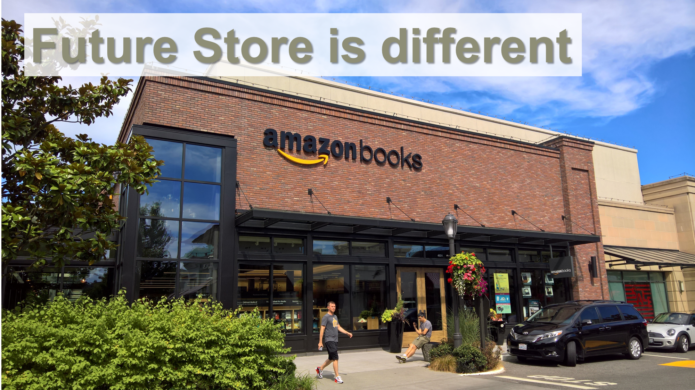A retail pro audit from Amazon’s brick & mortar book store in Seattle, a consumer experience with zero cross channel services. Only an app secured the sale.
I have to admit, I have a love-hate relationship with Amazon. As a consumer, I like their ultimate convenience for need shopping, yet find their attempts at inspiring my impulse shopping utterly over the top. As a brand and retail manager, I love them for demonstrating to the industry how to place the consumer at the center of strategic priorities. Then again, I don’t like seeing just how far along they’ve come in destroying whole market segments.

My overloaded Amazon landing page: a feminine offering and other suggestions far from my personal interests (Screenshot: Amazon.com)
So I travelled to Seattle with some curiosity about Amazon’s store operation, consumer experience and cross channel services. It was both a rich and surprising experience, which I share with you in two parts. This week from a ground floor consumer perspective and next week from a strategic boardroom view.
Amazon’s Stores Are Hard to Find
The journey to Amazon’s stores starts like 50-80% of consumers’ physical store visits: online.
| Definition: Cross Channel Services |
|---|
| The consumer services that a retailer provides to ease consumers’ information, communication and travel between its various distribution channels. An excellent journey allows consumers to check for new products online, find the next physical store, check the products’ in-store availability. At advanced retailers, the consumer can make a product reservation (click & reserve), buy online and pick up the product in-store (click & collect) and return items purchased online at the nearest store (buy online & return offline). |
My first approach to the store’s online presence is a short story: Amazon’s store is hard to find ‘in-house’. There is no store locator in Amazon’s online menu, a search for ‘Amazon Stores’ or ‘Amazon store locator’ on Amazon’ landing page returns surprising results:
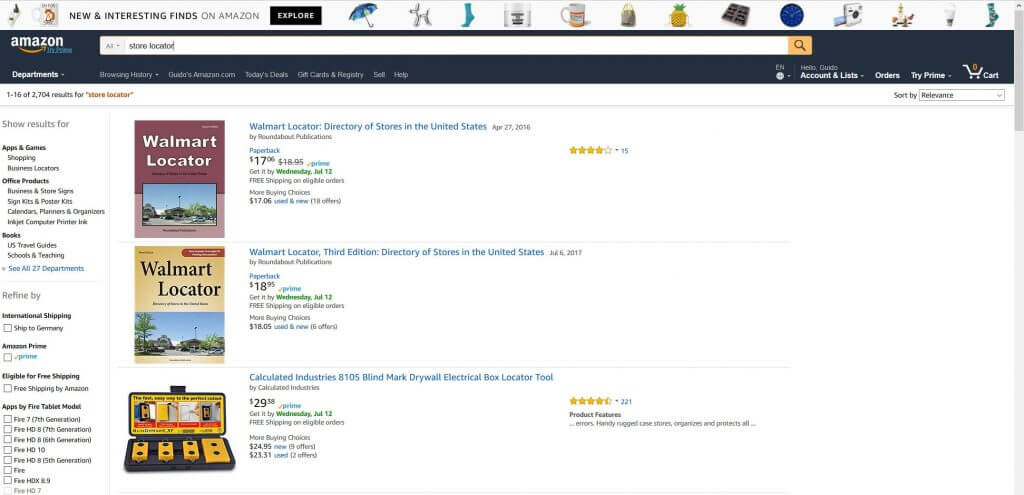
A Walmart Store Locator Book is what you get when searching the Amazon homepage for ‘Store Locator’ (Screenshot: Amazon.com)
My next attempt leads me to Facebook, where advanced retailers ((i.e. Starbucks) entertain pages for each store to provide good cross channel services. I find a page for the Amazon Seattle store; it shows 56 consumer ratings at an average of 4.2 (of 5). When reading the entries I realize only after two minutes, that is an unofficial page, with weird entries, and certainly not facilitated by Amazon.

The fake Amazon Book Store Page, if you are experienced enough to see it (Screenshot: Facebook)
I give it a second try at Facebook and find the official Facebook Amazon Book store page. It invites me to visit the store in Seattle, but again no opening hours or contact informations. No wonder, consumers continue to communicate on the fake page. The fake had far more information about the store.
The masters of search & find, Google, finally guide me to the information I was unable to locate on Amazon’s website: a list of Amazon’s current book stores, at the Amazon homepage:
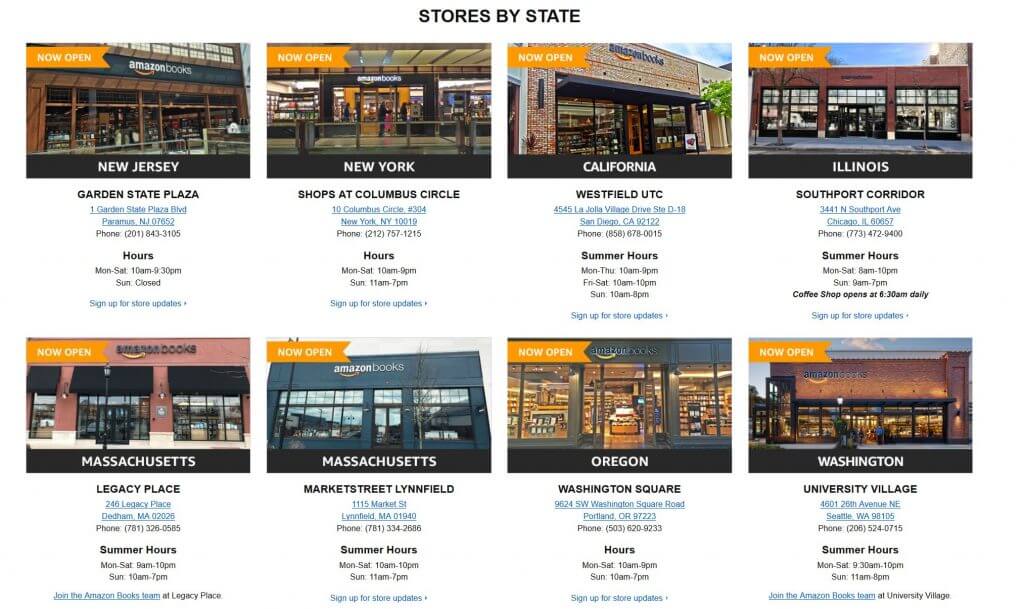
Amazon’s current 8 Brick & Mortar Stores – Or are there already 13 book stores? (Screenshot: Amazon.com)
So according to this page, eight stores are open at the time of my visit, and I find the opening hours. Interestingly though, Amazon’s email subscriber list I come across 10 minutes later lists 13 open stores.
As a consumer, I’m frustrated at how much effort it takes to find information about the stores. As a retail pro, I lean back and smile, realizing that Amazon faces the same challenges in cross channel services as most well-known retailers: It takes some time to ensure a seamless communication between the online and offline worlds. Amazon, welcome in the brick & mortar reality! Store SEO is something you may not have considered yet. So lets find out about your cross channel services.
Amazon’s Cross Channel Service Is Zero – But an App Saves the Basket
The store we visit is Amazon’s first brick & mortar store at the University Village Shopping Center in an affluent Seattle neighborhood. Situated 5 miles away from downtown, it is free from any impulse or tourist traffic. Judging by the village tenant mix and visitors it is a mid-market center. The store opened almost 2 years ago, so teething troubles should have passed.
Upon arrival, we receive a friendly welcome and are gently introduced to the basic store features. We learn that we need to be registered online customers, or register on the spot. While we are welcome to browse, there is no way Amazon would allow us to buy anonymously and with cash. Luckily for us, international customers are welcome.
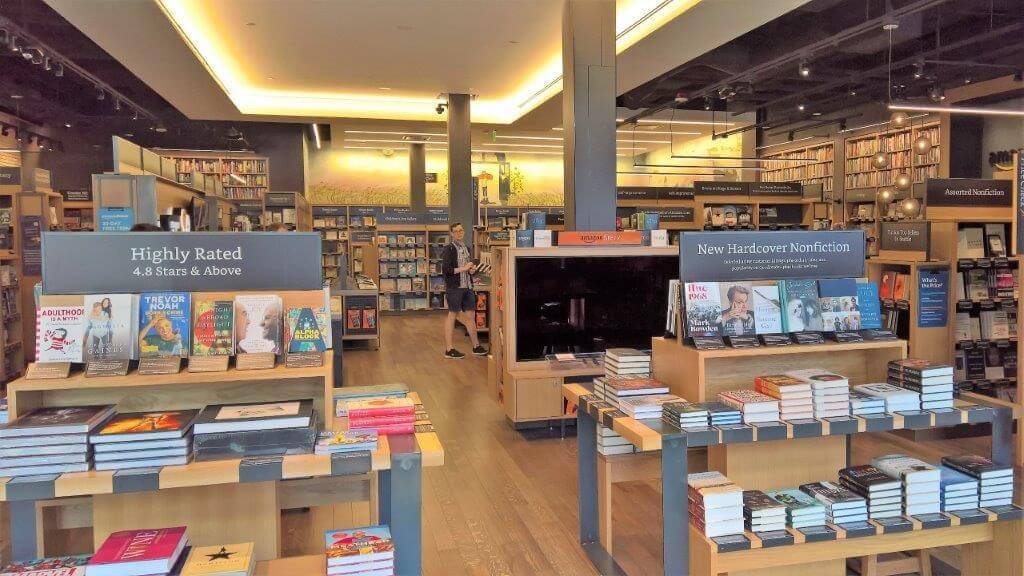
The stores ‘landing zone’, a narrow entry, but well curated (photo: brand pilots)
We browse our way through a tidy store that stocks 6000 titles (Source: Amazon) and is curated like an online shop. Shelf after shelf, all book covers are facing outwards, and a short book description sits on the shelf. Aisles are very narrow and don’t allow undisturbed browsing while others pass through.
And while we are excited and impressed at first, that impression fades the longer we stay. Possibly biased and in parts unfair, our very high brand expectation – putting the consumer at the center – clashes with the in-store experience. Take for example the book descriptions on the shelf: if you want to know the book’s price, you either have to walk to a price look-up terminal or use the phone app (which we didn’t have).
We are impressed by categories such as ‘All Books rated higher 4.8’, and amused about ‘Books Kindle Readers Finish in 3 Days or Less’ (is that quality category?). And we are very surprised when the Amazon’s otherwise well-oiled machine reveals stock-outs.

A stockout at Amazon, the last thing you would expect to see. If smart store clerks temporarily removed the display, consumers wouldn’t have noticed it (photo: brand pilots)
We ask for assistance on cook & marketing books and are guided to the appropriate shelf. But the staff can’t help with the content of books, or give recommendations, and refers us back to the shelf descriptions. We sense that the store is perfect for all need shoppers looking to buy a book from any type of top 20 list. It is a miss for those with questions, or those who want to immerse themselves in a wide selection and discover books beyond the many top lists. The store feels like online – a perfect place to rush need shoppers into a speedy purchase. If we could rate the cross channel service experience: 1 Star
At the end of our 45-minute visit, we carry four books and realize that since our arrival nobody actively offered us further assistance. We move towards the self-checkout. But worried about potential airline luggage overweight, we shy away from the purchase.
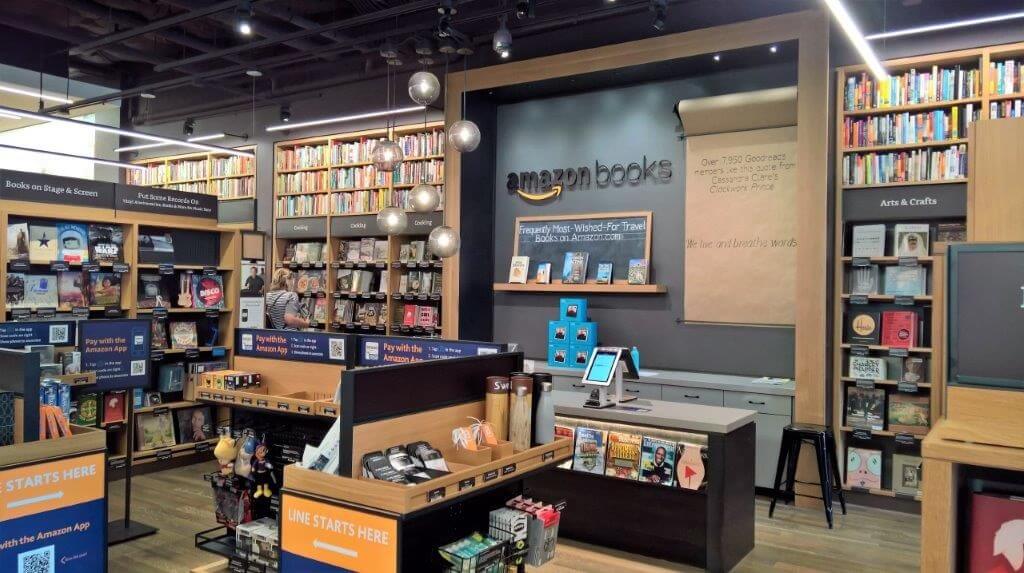
Amazon’s authentic 100% self-guided self-checkout (photo: brand pilots)
We ask the staff whether the books could be shipped home or ordered online. A shipping service isn’t available, and the store assistant doesn’t know about the books’ online availability. To our surprise, we receive no IPad assist offer and are left alone with our books and buying decision.
We decide to download the Amazon shopping app, to read the book covers and barcodes. Our download, book scan and online checkout take less than five minutes. We buy online. Now that is a great cross channel service.

The selection of our books that were left in store. But Amazon.com will ship us this selection, thanks to its app (photo: brand pilots)
We leave the store in Seattle without our books, but are grateful for the convenient online experience as well as the good feeling to save ourselves luggage surcharges. I should not forget to mention, we did ask about other cross channel services (click & reserve, click & buy, buy online & return) and learned they are also ‘not available’.
Amazon Is Not the Future in Brick & Mortar Retail
You may say, we should give Amazon more time to develop their brick & mortar retail. Hey, a company with those resources and a constant emphasis on putting customers at the center of attention is offering surprisingly mediocre cross channel services, 15 months after its store opening! There is hardly any retailer these days who doesn’t have at least one cross channel service, and Amazon tries to get away without cross channel service?
Maybe it was a mistake we spoiled our perspective by visiting Powell’s, a landmark bookstore in Portland, two days earlier. Besides of having well informed personnel, Powell’s has the store locator in its online menu and they have cross channel services, i.e. order online and pickup in-store.
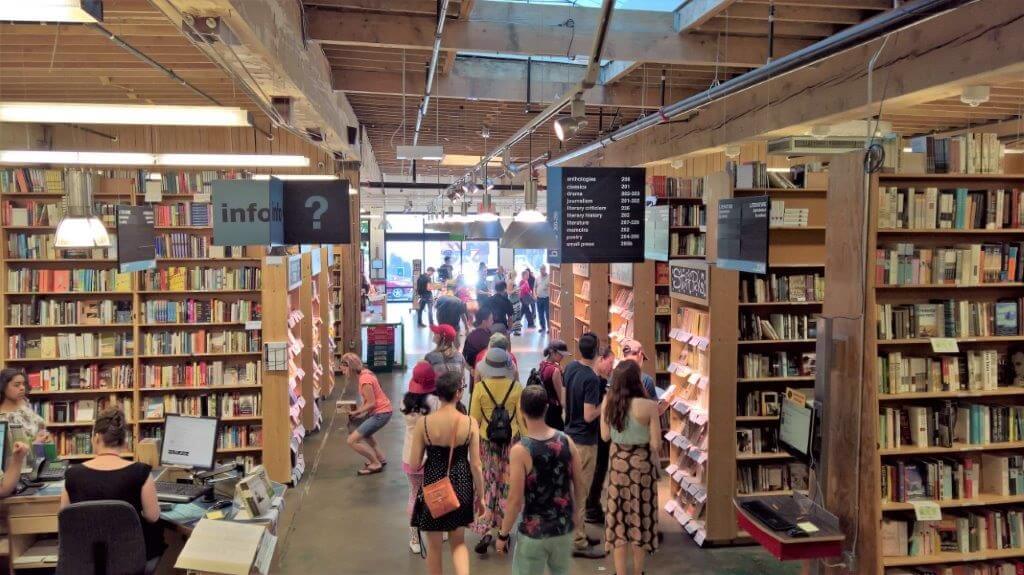
Powell’s lively book store in Portland (photo: brand pilots)
Seattle is Amazon’s hometown and we expected at least some semblance of a mini brand flagship with basic online services. ‘We talk about ourselves as a physical extension of Amazon.com,’ said Jennifer Cast, vice president of Amazon Books, on a press tour when opening the New York store in May. Well, that is literally all it is: a 1:1 brick & mortar copy of the online store, but certainly not the future in seamless online offline retail.
From a professional point of view, I would say that Amazon made the same mistake as many other made at their retail beginning. Brands, mail order companies or online shops that start physical stores create a ‘showroom’ of their company, but miss out on many opportunities to become a true retailer to consumers. The Amazon store feels like a 3D copy of the online store, a vehicle to drive people to the app and to become Prime members. But retail is more, and includes quality customer advice and cross channel services.
Amazon Books – A Convenience Store from 7 to 11
After all, our visit did lead to Amazon sales, and store statistics are unlikely to reveal our subpar experience. While the store triggered our impulse shopping, it didn’t leave us wanting to come back. Unlike Powell’s bookstore. The Amazon store feels more like a ‘7-Eleven of book shopping’; conveniently located in the neighborhood, offering bestsellers, ideal for speedy need shopping. If this is Amazon’s intention, they just need to add a few cross channel services, open from 7 to 11, with some coffee on the side, and there goes a perfect store format, ideal for airports and train stations, around the world.
Make sure you come back next week, for a review of Amazon’s overall retail strategy. A subscription of this blog and its weekly inspiration prevents that you miss it!
[do_widget id=email-subscribers-5]
About the Author
Guido has been working with well-known brands and retailers for over two decades. Store assessments and how to commercialize retail strategies have been a regular task. Guido is currently working on a book about global best practices for retail and brand growth management. For a dialogue on Amazon’s store, or your own stores, you reach him best by email.

